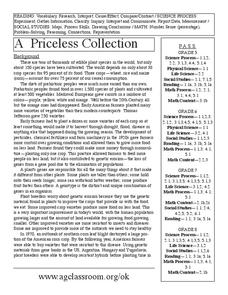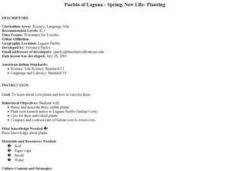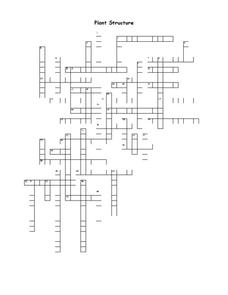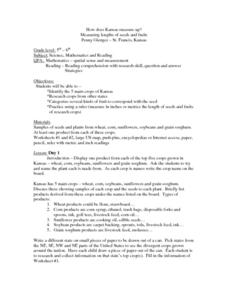Curated OER
A Priceless Collection
Students read and discuss the background of plants, seeds, and gene banks and grow seeds on their own. In this seeds lesson plan, students also use maps to identify seed banks and research plant farmers.
Curated OER
What is Rice?
Second graders investigate the agricultural process of rice farming by creating a rice stationary item. In this farming lesson plan, 2nd graders read about rice plants and the techniques used to harvest the edible plant. Students...
Curated OER
Pueblo of Laguna - Spring, New Life: Planting
Students name and describe three edible plants, plant corn kernels native to Laguna Pueblo (Indian Corn), care for their individual plants and compare and contrast ears of Indian corn to sweet corn.
Curated OER
Plant Parts We Eat
I bet the kids in your class will love to eat their vegetables after an engaging lesson plan about edible plants. They read information about vegetables and edible plants, sort vocabulary words, identify plant parts, measure and graph...
Curated OER
Tops and Bottoms
First graders classify vegetables by which parts are edible. In this plant biology lesson, 1st graders are read Tops and Bottoms by Janet Stevens, participate in a discussion of which plant parts are edible in the story, then sort real...
Curated OER
Yum Yum: Making Vegetable Soup
Students investigate agriculture by reading a book. In this plant life lesson, students read the book Growing Vegetable Soup by Louis Ehlert, and examine the ingredients used in the book's soup. Students create an experimental,...
Curated OER
PLANT PARTS WE EAT
Students identify an assortment of vegetables and learn how to locate the parts humans use for food. Students identify the plant parts we eat. Students color the pictures on their worksheets as provided. Students match the plants to the...
Curated OER
Growing Garden Companions.
Students understand that some plants grow better with other plants. In this companion planting lesson, students observe the "three sisters" growing system used by the Native Americans. Students understand that small gardens grow better...
Curated OER
Nutrients for Plants and People: Food Pyramid Garden
In this garden worksheet, students plant different types of food from the food pyramid into a garden and write a journal about all of the food. Students plant 4 levels of food from the food pyramid.
Curated OER
A Priceless Collection
Students read about and discuss life of Russian geneticist Nikolai Vavilov, define terms related to field of genetics, complete worksheets, conduct seed experiments, observe and record results, and locate seed banks on world map or globe.
Curated OER
Plant Structure
In this plant science worksheet, students complete a crossword puzzle with 48 questions. They identify the different parts of a plant.
Curated OER
Rosa Parks Community Garden
Ninth graders investigate how we depend on plants as the original source of most food. They investigate the parts of plants, and which parts are edible. Students are explained that the garden is also a classroom and the same rules apply.
Curated OER
Planning a Railroad Online Lesson
Students design a train route using a topographical map. In this historical and spatial thinking lesson plan, students must plan a route through the Sierra Nevada mountains that a train could physically travel. Links to printable student...
Curated OER
How Does Kansas Measure Up?
Students identify the five main crops of Kansas and crops that are produced in other states. The categorize the types of fruits and seeds of each plant and measure each to compare the length of each.
Curated OER
LISTENING TO DIRECTIONS
Students view farm objects or products made from farm animals and follow the oral instructions given by the teacher. They are given worksheets, there are three sets of directions for the one worksheet. Students worksheets have everything...
Curated OER
A PRICELESS Collection
Students read a story about the life of Russian plant breeder Nikolai I and Vavilov and the national seed bank he established. They research the Irish Potato Famine of the late 1840s and identify the cause for this famine and make...

















